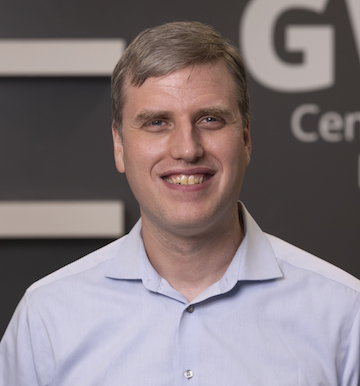Geoffrey Lovelace
Professor of Physics
Contact information
Email glovelace@fullerton.edu
Phone +1 (215) 740-9176
GitHub geoffrey4444
Mailing address
Department of Physics, MH-611
California State University, Fullerton
800 N State College Blvd.
Fullerton, CA 92834

About me
I am a professor in the Department of Physics at California State University, Fullerton. My current research interests focus on using numerical relativity to model sources of gravitational waves, such as merging black holes. I join professors Jocelyn Read, Josh Smith, and Al Agnew in Cal State Fullerton’s Nicholas and Lee Begovich Center for Gravitational-Wave Physics and Astronomy (GWPAC), and I also am a member of the Simulating eXtreme Spacetimes (SXS) collaboration and the LIGO Scientific Collaboration.
As a hobby, I also have made a couple of small apps for iOS and macOS.Research
At Cal State Fullerton, my research goals focus on modeling sources of gravitational waves using numerical relativity. Gravitational waves—ripples of spacetime curvature—are opening a new window on the universe. The Advanced Laser Interferometer Gravitational-wave Observatory (Advanced LIGO) has observed the first gravitational waves passing through Earth, which came from merging black holes. My students and I use supercomputers to simulate colliding black holes using the Spectral Einstein Code (SpEC), and we are particularly interested in modeling merging black holes that spin nearly as fast as possible and in responding to LIGO observations. I recently have begun using supercomputers to model thermal noise in LIGO mirrors, with the goal of helping to improve the sensitivity of next-generation detectors, and exploring how well gravitational-wave detectors can measure rapid black-hole spins.
I am contributing to the development of SpECTRE, the SXS Collaboration’s next-generation numerical-relativity code. Jocelyn Read, Josh Smith, and I am also contributing Cosmic Explorer, a concept for the next gravitational-wave observatory in the United States.
Starting in 2018, I am leading an annual one-week summer workshop that introduces students from local community colleges to gravitational waves and high-performance computing.
Publications
My up-to-date publication list is available through my full CV, Google Scholar and INSPIRES. My contributions to SpECTRE are available through GitHub.
CV
You can download my full CV in PDF format, including links to my publications.
Support
My students and I are grateful to thank the National Science Foundation, the Research Corporation for Science Advancement, the Louis Stokes Alliance for Minority Participation, California State University, Fullerton, Nicholas and Lee Begovich, Dan Black, and Nancy Goodhue-McWilliams. Our research is supported in part by the following external grants:
-
NSF grant EES-2332503. Planning Proposal: CREST Center for Gravitational-Wave Physics and Astronomy.
-
NSF grant PHY-2308985. Collaborative Research: Identifying and Evaluating Sites for Cosmic Explorer.
-
NSF grant AST-2219109. The CSUF-led partnership for inclusion of underrepresented groups in gravitational-wave astronomy.
-
NSF grant PHY-2208014. RUI: Next-Generation Numerical Relativity for Future Gravitational-Wave Observatories.
Our work has also been supported in the past by the following external grants:
-
NSF grant PHY-1654359. CAREER: Computational Gravitational-Wave Science and Education in the Era of First Observations.
-
NSF grant AST-1559694. The CSUF-Syracuse partnership for inclusion of underrepresented groups in gravitational-wave astronomy.
-
NSF grant PHY-1836734. Collaborative Research: The Next Generation of Gravitational Wave Detectors.
-
NSF grant PHY-1708035. Collaborative Research: LSC Center for Coatings Research.
-
NSF grant PHY-1606522. RUI: Computational Gravitational-Wave Research for the Era of First Observations.
-
NSF grant PHY-1429873. MRI: Acquisition of a High-Performance Computer Cluster for Gravitational-Wave Astronomy with Advanced LIGO.
-
Multi-investigator Cottrell College Science Award. Developing a numerical injection analysis pipeline for gravitational waves from merging black holes and neutron stars.
-
NSF grant PHY-1307489. RUI: Numerical Simulations of Merging Black Holes and Neutron Stars.
Teaching
I have taught the following courses:
-
Astronomy 101, an interactive, general introduction to astronomy.
-
Astronomy 444, “Applications of Gravitation,” a new course for advanced undergraduates that I am piloting, focusing on some applications of general relativity: black holes, gravitational waves, and cosmology.
-
College of Natural Sciences and Mathematics 101, "Think Like Einstein," an introductory course for science and math majors at Cal State Fullerton.
-
Physics 211, “Elementary Physics,” an algebra-based introduction to mechanics and thermodynamics.
-
Physics 211L, “Elementary Physics Laboratory”, the laboratory co-requisite to Physics 211.
-
Physics 225, “Fundamental Physics,” a calculus-based introduction to mechanics. I have redesigned this course using a flipped classroom, supported in part by the CSU Sustaining Success and Proven Course Resdesign redesign programs.
-
Physics 300, “Survey of Mathematical Physics”, a course that bridges the under-division and upper-division undergraduate physics major courses, introducing key mathematical tools while emphasizing how to think about math like a physicist.
-
Physics 330A and 330B, “Electromagnetic Theory I and II”, an upper-division course on electromagnetic theory.
-
Physics 520, “Analytical Mechanics,” a master’s-level course in classical mechanics and special relativity.
Movies
What merging black holes look like
The source of LIGO's first observation of gravitational waves was a pair of merging black holes. This movie shows what the merging black holes would look like up close, in slow motion (about 100 times slower than real time). Credit: SXS Collaboration.
LIGO orreries
Inspired by the Kepler Orrery visualization, this movie visualizes the binary black holes LIGO observed during its first two observing runs. Credit: Teresita Ramirez Aguilar/Geoffrey Lovelace/SXS Collaboration/LIGO-Virgo Collaboration.
This follow-up simulation visualizes the merging black holes seen through the first part of LIGO's third observing run. Credit: Teresita Ramirez Aguilar/Geoffrey Lovelace/SXS Collaboration/LIGO-Virgo Collaboration.
Apps
As a hobby, I have made some small apps for iOS and macOS:- ImageInversion, a simple app to easily invert the colors of images. I made it to help me easily convert graphics to dark mode, since I like using dark backgrounds on my slides.
- CalcBits, a calculator that shows you how double-precision floating-point numbers are represented in memory, in binary and in hexadecimal. I wrote this little app to help me visualize how doubles work.